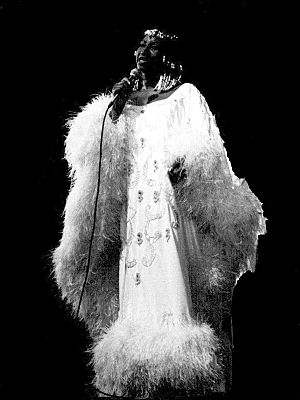Celia Cruz facts for kids
Quick facts for kids
Celia Cruz
|
|
|---|---|
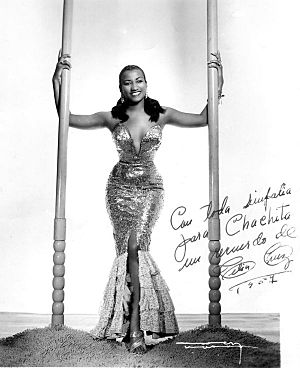
Cruz in 1957
|
|
| Born |
Úrsula Hilaria Celia de la Caridad Cruz Alfonso
21 October 1925 |
| Died | 16 July 2003 (aged 77) Fort Lee, New Jersey, U.S.
|
| Resting place | Woodlawn Cemetery (Bronx, New York) |
| Occupation |
|
| Years active | 1948–2003 |
| Spouse(s) |
|
| Musical career | |
| Genres |
|
| Instruments |
|
| Labels |
|
Úrsula Hilaria Celia de la Caridad Cruz Alfonso (born October 21, 1925 – died July 16, 2003), known as Celia Cruz, was a famous Cuban-American singer. She was one of the most popular Latin artists of the 20th century. Celia Cruz became famous in Cuba in the 1950s for singing guaracha music. People called her "La Guarachera de Cuba" (The Guaracha Singer of Cuba). Later, she became known worldwide as the "Queen of Salsa" because of her huge impact on Latin music.
She started her career in Cuba with the popular group Sonora Matancera. She sang with them for fifteen years (1950-1965). Celia was great at many Afro-Cuban music styles. These included guaracha, rumba, afro, son, and bolero. She recorded many songs in these styles. In 1960, after the Cuban Revolution, Celia left Cuba. She became a voice for Cubans living outside their home country.
Celia continued her music career, first in Mexico and then in the United States. She made the U.S. her permanent home. In the 1960s, she worked with Tito Puente. They recorded her famous song "Bemba colorá". In the 1970s, she joined Fania Records. She became strongly linked with salsa music. Hits like "Quimbara" made her even more famous. She often performed live with the Fania All-Stars. She also worked with Johnny Pacheco and Willie Colón. Later in her career, Celia released more successful songs. These included "La vida es un carnaval" and "La negra tiene tumbao".
Celia Cruz recorded 37 studio albums, plus many live albums and collaborations. She won many awards, including two Grammy Awards and three Latin Grammy Awards. Besides music, she also acted in movies and telenovelas (soap operas). Her famous catchphrase "¡Azúcar!" ("Sugar!") is now a well-known symbol of salsa music.
Contents
Early Life
Úrsula Hilaria Celia de la Caridad Cruz Alfonso was born on October 21, 1925. Her home was in the Santos Suárez neighborhood of Havana, Cuba. Her father, Simón Cruz, worked on railways. Her mother, Catalina Alfonso Ramos, was a housewife. Celia was one of the oldest of fourteen children living in their home. This included her cousins and her three siblings. She often sang lullabies to help them sleep. Her mother said Celia started singing when she was only 9 or 10 months old. She also sang at school events and in her neighborhood group.
Growing up in Cuba in the 1930s, Celia heard many musicians. These artists influenced her own music career. Even though her father didn't approve, Celia learned Santería songs. She learned them from a neighbor who practiced Santería. Celia also studied Yoruba songs. She even recorded religious songs and sang backup for other singers.
As a teenager, her aunt took her to cabarets to sing. But her father wanted her to become a teacher. After high school, she went to a teacher's school in Havana. She planned to be a literature teacher. At that time, being a singer was not seen as a very respected job. However, one of her teachers told her that entertainers could earn a lot more money. From 1947, Celia studied music, voice, and piano at Havana's National Conservatory of Music.
One day, her cousin took her to Radio García-Serra, a radio station in Havana. She joined an amateur radio show called "Hora del té". It was her first time using a microphone. She sang the tango "Nostalgia" and won a cake as the first prize. She won other contests too, earning silver chains and more chances to perform. She always won first prize in other amateur radio shows.
Career
First Steps in Music
Isolina Carrillo was one of the first people to see Celia's talent for Afro-Cuban music. She asked Celia to join her group, Conjunto Siboney. Celia later joined other orchestras like Orquesta de Ernesto Duarte. From 1947, she began singing in Havana's most popular cabarets. These included Tropicana and Sans Souci. In 1948, Roderico Rodney Neyra started a group of dancers and singers called Las Mulatas de Fuego. Celia was hired as a singer for this group. They became very successful and performed in Mexico and Venezuela. Celia made her first recordings there. Soon after, Celia started singing on radio shows. She performed with a group that played Santería music.
Joining Sonora Matancera
Celia's big chance came in 1950. The singer for Cuba's Sonora Matancera group left. The band needed a new singer and decided to give Celia a try. She auditioned in June and joined as the lead singer in July. She became the group's first black female singer. At her first rehearsal, Celia met Pedro Knight, who played trumpet in the band. He later became her husband. Celia first performed with the group on August 3, 1950.
At first, the public was not very excited about Celia. But Rogelio Martínez, the band leader, believed in her. On December 15, 1950, Celia recorded her first songs with the group. They were a huge success. Her musical journey with Sonora Matancera lasted fifteen years. Celia recorded 188 songs with them. Famous hits included "Cao cao maní picao" and "Burundanga". She won her first gold record for "Burundanga". She traveled to the United States in 1957 to get her award and perform. During her 15 years with Sonora Matancera, she appeared in Mexican films. She also toured all over Latin America and was a regular performer at the Tropicana.
Life in Exile
On July 15, 1960, after the Cuban Revolution, Sonora Matancera got a contract to perform in Mexico. Celia never thought she would not return to Cuba. The new Cuban government did not like the group working abroad, especially in the United States. So, the government stopped her from returning to Cuba. While in Mexico, she learned her father had passed away. In 1961, Celia and Sonora Matancera left Mexico for the United States. During this time, Celia started performing alone.
In 1962, since the Cuban government would not let her return, Celia bought a house in New York. She tried to go back to Cuba to see her sick mother, but the government said no. On April 7, 1962, her mother passed away. That same year, on July 14, Celia married Pedro Knight. Celia and Sonora Matancera then toured Europe and Japan. In Japan, they performed with Tito Puente. In 1965, Celia left Sonora Matancera to start her solo career. Pedro Knight left the band to become her manager. During this time, Celia became an American citizen.
In 1966, Tito Puente asked Celia to perform with his orchestra. Their first album together, Son con guaguancó, included "Bemba colorá". This song became one of Celia's most famous. Celia and Puente made four more albums together. She also recorded albums with other music directors. In 1974, Fania Records, a top salsa label, signed Celia. She stayed with them until 1992.
The Fania Years
Celia's work with the Fania label began in 1973. She sang on a song called "Gracia divina" for Larry Harlow's "Latin opera". She then joined the Fania All-Stars. This was a salsa supergroup with the most popular Fania artists. With them, Celia first sang "Bemba colorá" in San Juan, Puerto Rico in 1973. She later traveled with the group to Kinshasa, Zaire, in 1974. Her performance in Zaire was part of a big event and was shown in the film Soul Power.
Celia recorded her first studio album for Fania in 1974 with Johnny Pacheco. The album, Celia & Johnny, and its main song, "Quimbara", were very successful. In 1976, she was in a documentary film called Salsa. The next year, she recorded her first album with Willie Colón. They worked together again in 1981 and 1987. When touring with Colón, Celia wore amazing costumes. These included colorful wigs, sparkly dresses, and very high heels. Her style became so famous that one of her outfits is now in the Smithsonian museum.
In 1982, Celia reunited with the Sonora Matancera. They recorded the album Feliz Encuentro. That year, Celia received her first tribute concert in New York. In 1987, Celia performed a concert in Santa Cruz de Tenerife. This concert was recognized by the Guinness Book of Records as the largest free outdoor concert. About 250,000 people attended. In 1988, she was in the film Salsa. In 1990, Celia won her first Grammy Award for her album Ritmo en el corazón. She was also invited to celebrate Sonora Matancera's 65th anniversary.
Later Years
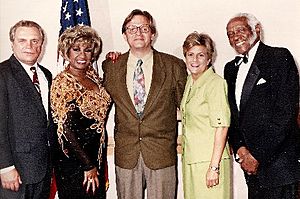
In 1990, Celia Cruz was able to return to Cuba for a visit. She was invited to perform at the Guantanamo Bay Naval Base. When she left, she took a small bag of Cuban soil with her. She asked for it to be placed in her coffin when she died. In 1994, she received the National Endowment for the Arts award. This is the highest honor the United States government gives to an artist.
Celia had performed in Mexican and Cuban films. In 1992, she acted in the American film Mambo Kings. A year later, she debuted as a TV actress in the Mexican telenovela Valentina. In 1995, Celia made a guest appearance in the American film The Perez Family. In 1997, she starred in another Mexican telenovela, El alma no tiene color. On October 25, 1997, the city of San Francisco, California, declared that day "Celia Cruz Day".
In 1998, she released the album Mi vida es cantar. It included one of her most successful songs, "La vida es un carnaval". In 1999, she performed with Luciano Pavarotti at a concert. In 2000, Celia released a new album, Celia Cruz and Friends: A Night of Salsa. She recorded with Tito Puente again, who passed away shortly after. This album earned Celia her first Latin Grammy. In 2001, her album Siempre viviré won her a second Latin Grammy. That same year, she performed with Marc Anthony. In 2002, Celia released La negra tiene tumbao. This album mixed Caribbean rhythms with rap and hip hop. It won her a third Latin Grammy and her second American Grammy.
On July 16, 2002, Celia performed at the Central Park SummerStage festival in New York City. She sang "Bemba colorá" to a large crowd.
Death
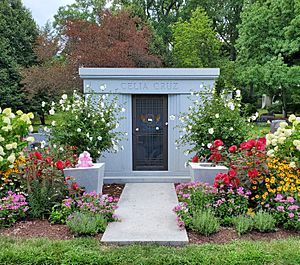
In 2002, Celia Cruz had surgery. In November that year, she fell during a concert in Mexico. She was diagnosed with brain cancer and had surgery in December. Celia remained hopeful and finished recording her last album, Regalo del Alma. In February 2003, she appeared in public at the 45th Annual Grammy Awards. She received an award for Best Salsa Album. In March 2003, the US Hispanic network Telemundo honored her. The event, called ¡Celia Cruz: Azúcar!, featured many famous artists. This was her last public appearance.
On the afternoon of July 16, 2003, Celia Cruz passed away at her home in Fort Lee, New Jersey. She was 77 years old. As she wished, her body was first taken to Miami for two days. This was so her Cuban fans could pay their respects. Then, she was laid to rest in the Woodlawn Cemetery in The Bronx, New York. The Cuban soil she had saved from her visit to Guantánamo Bay was placed in her coffin.
Tributes and Legacy
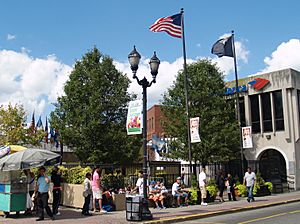
Celia Cruz's legacy has been honored even before her death. She received a star on the Hollywood Walk of Fame in 1987. An asteroid was named 5212 Celiacruz in 1989. She also received the Lo Nuestro Excellence Award in 1990. A street in Miami was named Celia Cruz Way in 1991. She also has a star in Caracas, Venezuela, and a figure in the Hollywood Wax Museum. Celia received honorary doctorates from three U.S. universities. These were Yale University, Florida International University, and the University of Miami.
Celia Cruz and fellow musician Cachao were inducted into the Billboard Latin Music Hall of Fame in 1994. She was also inducted into the International Latin Music Hall of Fame in 1999. In the same year, she received the ASCAP Latin Heritage Award.
Celia worked very hard and reached the top of her music style. In February 2004, her last album, Regalo del Alma, won a posthumous award. It was for best salsa release of the year. In December 2005, a musical called ¡Azúcar! was announced. It would open in Tenerife and then tour the world. The name comes from Celia's famous catchphrase, "¡Azúcar!" (“Sugar!”).
In 2003, a music school opened in the Bronx, New York. It was named the Celia Cruz Bronx High School of Music. Pedro Knight visited this school before he passed away. He met the students and shared stories about Celia's life. On June 4, 2004, Union City, New Jersey, dedicated its new Celia Cruz Park. It has a sidewalk star in her honor. Celia's star is part of Union City's "Walk of Fame." New stars are added each spring to honor Latin entertainers.
On May 18, 2005, the National Museum of American History in Washington, D.C., opened an exhibit. It was called "¡Azúcar!" and celebrated Celia Cruz's life and music. The exhibit showed important moments from her life. It included photos, personal items, costumes, videos, and music. Her biography Celia: Mi vida was also published in 2005. It was based on over 500 hours of interviews. From September 26, 2007, to May 25, 2008, a musical based on her life played Off-Broadway.
On March 16, 2011, the United States Postal Service honored Celia Cruz. They released a commemorative postage stamp. The Cruz stamp was part of a group of five stamps honoring Latin music greats. These included Selena and Tito Puente. On October 21, 2013, Google honored her with a Google Doodle. Jennifer Lopez honored Celia with a performance at the American Music Awards of 2013. Other singers also paid tribute to her. In 2013, Celia was inducted into the New Jersey Hall of Fame. In October 2015, Telemundo premiered a TV show about Celia's life, Celia.
In 2015, the television networks RCN Televisión and Telemundo made a TV series. It was also called Celia and was based on her life. In 2019, Angélique Kidjo released a tribute album to Celia. It was called Celia and featured her songs with an Afrobeat feel.
In 2018, a monument to Celia Cruz was unveiled. It is in the Cuban Heritage Park in Hialeah, Florida. Also in 2018, the Celia Cruz Estate launched a brand. It featured merchandise inspired by Celia.
On June 2, 2021, New York City honored Celia Cruz. They co-named an intersection near the High School in her honor. It is now called "Celia Cruz Way". In February 2023, Celia Cruz was chosen as an honoree for the 2024 American Women quarters program. This makes her the first Afro-Latina to appear on a U.S. quarter.
Discography
- Cuba's Foremost Rhythm Singer (1958)
- Incomparable Celia (1958)
- Mi Diario Musical (1959)
- Canciones Premiadas (1961)
- Homenaje a Los Santos (1964)
- Canciones que Yo Quería Haber Grabado Primero (1965)
- Sabor y Ritmo de Pueblos (1965)
- Cuba Y Puerto Rico Son (1966)
- Son con Guaguancó (1966)
- Bravo Celia Cruz (1967)
- A Ti México (1967)
- Excitante (1968)
- Serenata Guajira (1968)
- Quimbo Quimbumbia (1969)
- Etc. Etc. Etc. (1970)
- Celia y Tito Puente en España (1971)
- Celia Cruz/Tito Puente Algo Especial Para Recordar (1972)
- Celia & Johnny (1974)
- Tremendo Caché (1975)
- Recordando El Ayer (1976)
- Only They Could Have Made This Album (1977)
- Homenaje A Beny More (1978)
- Celia Cruz Y La Sonora Ponceña La Ceiba (1979)
- Celia/Johnny/Pete (1980)
- Celia & Willie (1981)
- Feliz Encuentro (1982)
- Tremendo Trío (1983)
- Candela (1986)
- De Nuevo (1986)
- Winners (1987)
- Ritmo en el Corazón (1988)
- Guarachera del Mundo (1990)
- Canta Celia Cruz (1991)
- Reina del Ritmo Cubano (1991)
- Tributo a Ismael Rivera (1992)
- Verdadera Historia (1992)
- Azucar Negra (1993)
- Boleros Polydor (1993)
- Homenaje a Beny Moré, Vol. 3 (1993)
- Introducing (1993)
- Guaracheras de La Guaracha (1994)
- Homenaje a Los Santos (1994)
- Irrepetible (1994)
- Mambo del Amor (1994)
- Merengue Saludos Amigos (1994)
- Cuba's Queen of Rhythm (1995)
- Double Dynamite (1995)
- Festejando Navidad (1995)
- Irresistible (1995)
- Celia Cruz Delta (1996)
- Cambiando Ritmos (1997)
- Duets (1997)
- También Boleros (1997)
- Afro-Cubana (1998)
- Mi Vida Es Cantar (1998)
- En Vivo C.M.Q., Vol. 4 (1999)
- En Vivo C.M.Q., Vol. 5 (1999)
- En Vivo Radio Progreso, Vol. 1 (1999)
- En Vivo Radio Progreso, Vol. 2 (1999)
- En Vivo Radio Progreso, Vol. 3 (1999)
- Celia Cruz and Friends: A Night of Salsa (1999)
- Habanera (2000)
- Salsa (2000)
- Siempre Viviré (2000)
- La Negra Tiene Tumbao (2001)
- Hits Mix (2002)
- Unrepeatable (2002)
- Homenaje a Beny Moré (2003)
- Regalo del Alma (2003)
- Dios disfrute a la Reina (2004)
- Havana Nights (2019)
Filmography
- Salón México (Mexico, 1950)
- Una gallega en La Habana (Mexico, 1952)
- ¡Olé... Cuba! (Mexico/Cuba, 1957)
- Affair in Havana (USA/Cuba, 1957)
- Amorcito Corazón (Mexico, 1960)
- Salsa (Documentary, 1976)
- Salsa (USA, 1988)
- "Fires Within" (USA, 1991)
- The Mambo Kings (USA, 1992)
- Valentina (TV) (Mexico, 1993)
- The Perez Family (USA, 1995) Luz Pat
- El alma no tiene color (TV) (Mexico, 1997)
- ¡Celia Cruz: Azúcar! (TV) (Tribute, USA, 2003)
- Soul Power (Documentary of Kinshasa, Zaire Music Festival 1974) (USA, 2008)
- CELIA, Celia Cruz Bio-Drama (2015 on Telemundo)
Awards
Grammy Awards
The Grammy Awards are given out every year in the United States. Celia Cruz won two awards from fourteen nominations. She also received a special Lifetime Achievement award.
| Year | Nominee / work | Award | Result |
|---|---|---|---|
| 1979 | Eternos | Best Latin Recording | Nominated |
| 1983 | Tremendo Trío | Best Tropical Latin Recording | Nominated |
| 1985 | De Nuevo | Nominated | |
| 1986 | Homenaje A Beny More - Vol. III | Nominated | |
| 1987 | The Winners | Nominated | |
| 1989 | "Ritmo En El Corazón" | Won | |
| 1992 | Tributo a Ismael Rivera | Best Tropical Latin Album | Nominated |
| 1993 | Azúcar Negra | Nominated | |
| 1995 | Irrepetible | Best Tropical Latin Performance | Nominated |
| 1997 | "Guantanamera" | Best Rap Performance for a Duo or Group | Nominated |
| 1998 | Mi Vida Es Cantar | Best Tropical Latin Performance | Nominated |
| 2000 | Celia Cruz and Friends: A Night of Salsa | Best Salsa Album | Nominated |
| 2002 | La Negra Tiene Tumbao | Nominated | |
| 2003 | Regalo del Alma | Best Salsa/Merengue Album | Won |
Grammy Lifetime Achievement Award
The Grammy Lifetime Achievement Award is given to artists who have made amazing contributions to music throughout their lives. Celia Cruz won this award in 2016.
| Year | Nominee / work | Award | Result |
|---|---|---|---|
| 2016 | Herself | Grammy Lifetime Achievement Award | Won |
Latin Grammy Awards
A Latin Grammy Award is an award given to recognize great achievements in the music industry. Celia Cruz won four awards out of seven nominations.
| Year | Nominee / work | Award | Result |
|---|---|---|---|
| 2000 | Celia Cruz and Friends: A Night of Salsa | Best Salsa Album | Won |
| 2001 | Siempre Viveré | Best Traditional Tropical Album | Won |
| 2002 | "La Negra Tiene Tumbao" | Record of the Year | Nominated |
| Best Music Video | Nominated | ||
| La Negra Tiene Tumbao | Album of the Year | Nominated | |
| Best Salsa Album | Won | ||
| 2004 | Regalo del Alma | Best Salsa Album | Won |
Celia Cruz also received the president's National Medal of Arts.
See also
 In Spanish: Celia Cruz para niños
In Spanish: Celia Cruz para niños
- Honorific nicknames in popular music
- Music of Cuba
- History of Cuba
- Pedro Knight - Celia's musician husband
- List of Cubans



